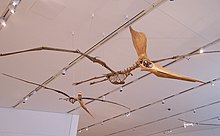Geosternbergia sternbergi
|
Geosternbergia Temporal range: Late Cretaceous, 88–80.5 Ma |
|
|---|---|
 |
|
| Mounted female and male G. sternbergi skeletons at the Royal Ontario Museum | |
| Scientific classification | |
| Kingdom: | Animalia |
| Phylum: | Chordata |
| Order: | †Pterosauria |
| Suborder: | †Pterodactyloidea |
| Family: | †Pteranodontidae |
| Genus: |
†Geosternbergia Miller, 1978 |
| Species | |
|
|
| Synonyms | |
|
|
Geosternbergia is an extinct pteranodontid reptile from the Late Cretaceous geological period of North America. It was one of the largest pterosaur genera and had a wingspan of up to 7.25 metres (23.8 ft).
Geosternbergia was among the largest pterosaurs, with the wingspan of most adults ranging between 3–6 metres (9.8–19.7 ft). No complete skulls of adult males have been found, but a nearly complete lower jaw has been estimated at 1.25 metres (4.1 ft) long. While most specimens are found crushed, enough fossils exist to put together a detailed description of the animal. Geosternbergia sternbergi was very similar to the more well-known pterosaur species Pteranodon longiceps and is often considered simply an earlier species of Pteranodon itself. It is different from Pteranodon mainly due to its earlier time period and broader, more upright crest.
The most distinctive characteristic of Geosternbergia is its cranial crest. These crests consisted of skull bones (frontals) projecting upward and backward from the skull. The size and shape of these crests varied due to a number of factors, including age, gender, and species. Male G. sternbergi, the older species of the two described to date, had a larger vertical crest with a broad forward projection, while G. maysei had a short, rounded vertical crest and was generally smaller. Females of both species were smaller and bore small, rounded crests. The crests were probably mainly display structures, though they may have had other functions as well.
The first G. sternbergi fossil was collected by George F. Sternberg in 1952 and described by John Christian Harksen in 1966, from the lower portion of the Niobrara Formation. It was older than Pteranodon longiceps and is considered by Bennett to be the direct ancestor of that species.
The most complete example of the species, currently in the collections of the University of Alberta Laboratory for Vertebrate Paleontology as specimen number UALVP 24238, is a partially-articulated sub-adult fossil with a wingspan of about 4 metres (13 ft). The skeleton is missing only parts of the skull and the ends of the wings and feet, was discovered in 1974 near Utica, Kansas. The fossil was found by Richard C. Fox and Allen Lindoe in rocks belonging to the lower part of the Smoky Hill Chalk Member of the Niobrara Formation. These rocks date to the late Coniacian or early Santonian stage, about 86 million years ago. In 2010, a paper by Alexander W.A. Kellner argued that this specimen was different enough from G. sternbegi that it should be re-classified as its own genus and species, which he named Dawndraco kanzai. This generic name combined the Dawn deity of the Iroquois with a Latin draco, "dragon". The specific name refers to the Kanza tribe of Kansas. Kellner thought that several features of the skeleton supported his hypothesis that D. kanzai was a unique species, most notably its unique snout, which does not strongly taper towards the tip as in female Pteranodon specimens, with the upper and lower margins running almost parallel instead. Kellner thought this meant the specimen must have had a crest running along the length of the snout. However, a re-examination of the fossil published in 2017 by Elizabeth Martin-Silverstone and colleagues argued that the differences in the snout were more likely due to male pteranodontids having longer, broader bills than the more complete female specimens Kellner used for comparison. Martin-Silverstone concluded that "Dawndraco" was simply a male G. sternbergi with a very long bill with a gradual taper.
...
Wikipedia
